Bromeliads, or Bromeliaceae, are an easy way to add texture, colour and a tropical feel to your indoors or garden. This adaptable epiphyte is an exotic South American native, boasting over 3,000 different species.
Their inflorescence (flowering parts) and curious shape make them a fantastic choice for indoor gardens, balconies or patios. Here is everything you need to know about Bromeliads, why you should grow them and how to take care of them.
More...
What Do Bromeliads Look Like?
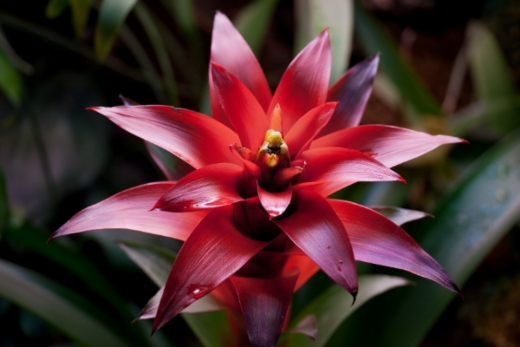
While there are a vast variety of Bromeliad species, each with its own quirks, they are all incredibly unusual plants. These adaptable growers have unusually thick foliage that grows in a rosette formation, creating an almost cup-like shape at the base.
Their inflorescence (or flowers) come in a wide range of forms and colours, depending on which species you buy.
As they are natural epiphytes like Epiphyllums, you will usually find these cultivars growing on other trees or along rocks in the wild. However, many species also do well in soil.
Why Grow Bromeliads?
Bromeliads are incredibly adaptable, especially in lower light conditions, and require relatively basic care. Common reasons as to why people grow bromeliads include:
- They’re easily grown indoors.
- They’re not too fussy if you forget to water them every now and then.
- They offer a wide range of forms and foliage.
- They reproduce quite rapidly and consistently.
- They have very little to no pest and disease issues.
Which Are the Best Bromeliads to Grow?
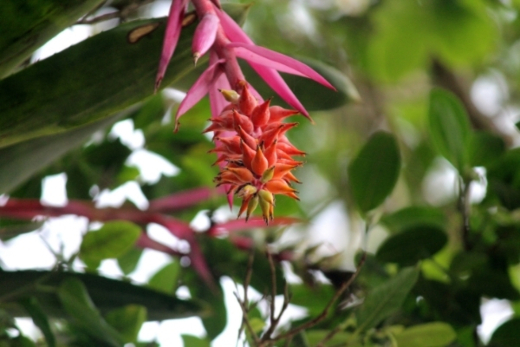
There really are so many bromeliads to choose from, each boasting a brighter, more beautiful and curiously quirky foliage. Common genus include:
Silver Vase Plant (Aechmea)This genus is a well-growing epiphyte that is tank flowering. It’s an amazing choice if you want bright flowers that hold for months on end. | 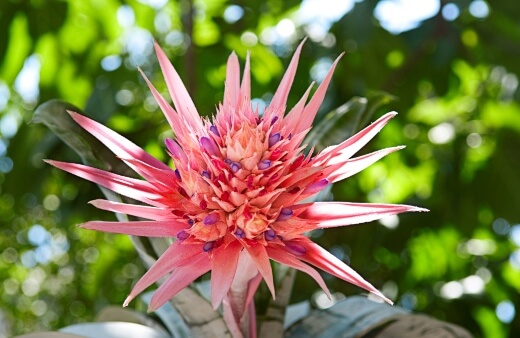 |
Queen's Tears (Billbergia)This genus grows in an intriguing, vase-like shape. This type is grown most throughout Brazil. If choosing this genus, be sure to avoid over-fertilising as it will otherwise lose it’s fantastic vase-like shape. |  |
Earth Stars (Cryptanthus)Also known as Earth Stars due to their curious shape, this gorgeous genus is great for spots that only get indirect light. They are, however, true terrestrials and will need to be planted in soil. |  |
Tufted Airplant (Guzmania)This is a shade-thriving species with stunningly dark and shiny leaves. Not only are they ideal for indoors, but they are also mostly grown for their intriguing inflorescence that lasts for months on end. |  |
Flaming Sword (Vriesea)This genus produces sword-shaped leaves and spike-like flower shoots and are extremely adaptable. Whether you decide to keep it in full sun or full shade, it will definitely be an eye-catcher. | 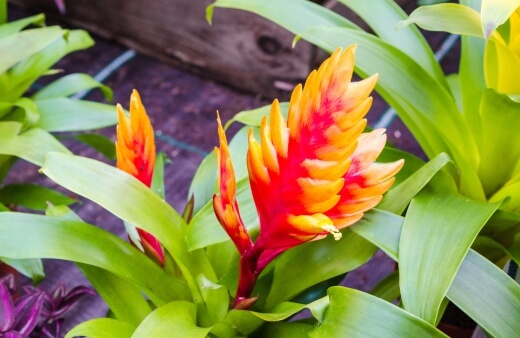 |
Blushing Bromeliad (Neoregelia)While this genus doesn’t come with any kind of showy flowers, it has some of the most magnificent foliage of all bromeliad species. In the right conditions, the innermost leaves will turn a bright red or pink. They will, however, need quite a bit of light. |  |
Airplant (Tillandsia)This is an arid environment loving genus, with silvery-grey foliage rather than green. If you tend to neglect or forget your indoor plants, this is an absolute go-to choice for you. | 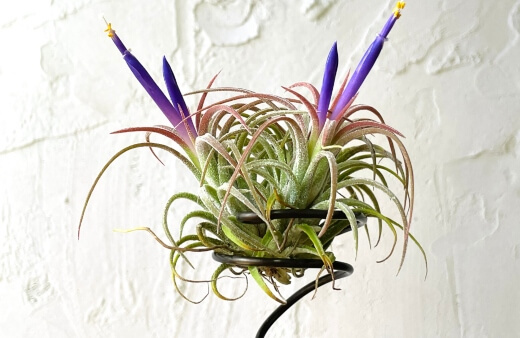 |
Silver Vase Plant (Aechmea)

This genus is a well-growing epiphyte that is tank flowering. It’s an amazing choice if you want bright flowers that hold for months on end.
Plus, this genus forms plant colonies rather than producing off-shoots like many of its counterparts.
Queen's Tears (Billbergia)

This genus grows in an intriguing, vase-like shape. This type is grown most throughout Brazil. If choosing this genus, be sure to avoid over-fertilising as it will otherwise lose it’s fantastic vase-like shape.
Earth Stars (Cryptanthus)

Also known as Earth Stars due to their curious shape, this gorgeous genus is great for spots that only get indirect light. They are, however, true terrestrials and will need to be planted in soil.
This genus cannot absorb water or nutrients through their leaves, so need somewhere to root.
Tufted Airplant (Guzmania)

This is a shade-thriving species with stunningly dark and shiny leaves. Not only are they ideal for indoors, but they are also mostly grown for their intriguing inflorescence that lasts for months on end.
Flaming Sword (Vriesea)

This genus produces sword-shaped leaves and spike-like flower shoots and are extremely adaptable. Whether you decide to keep it in full sun or full shade, it will definitely be an eye-catcher.
Blushing Bromeliad (Neoregelia)

While this genus doesn’t come with any kind of showy flowers, it has some of the most magnificent foliage of all bromeliad species. In the right conditions, the innermost leaves will turn a bright red or pink. They will, however, need quite a bit of light.
Airplant (Tillandsia)

This is an arid environment loving genus, with silvery-grey foliage rather than green. If you tend to neglect or forget your indoor plants, this is an absolute go-to choice for you.


Get Your Free Guide:
Master Growing Australian Natives eBook
A Must Have Complete Guide for Every Australian Garden
Get Your Free Guide:
Master Growing Australian Natives eBook
A Must Have Complete Guide for Every Australian Garden
How to Grow Bromeliads in Australia
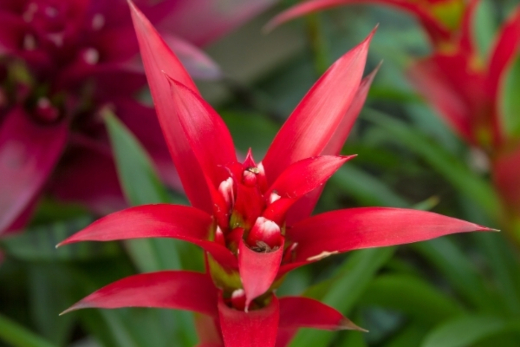
These attractively coloured house plants are widely available from most local garden centres. Depending on which species you purchase, they can be grown in the following three ways:
- Epiphytic. (Grown in the air or attached to a log)
- Saxicolous. (On-top and around rocks)
- Terrestrial. (In the ground/soil)
Should you choose to grow your Bromeliad in soil, it’s essential to select a shallow pot and a low-soil growing medium, such as orchid mix or a combination of bark and coconut coir.
In terms of temperature, bromeliads definitely prefer a warmer, tropical climate, so it would be best to keep them indoors, especially in winter.
Do Bromeliads Need Sun or Shade?
Again, this may depend on the species you have chosen to grow. If growing indoors, you’ll want to ensure medium to bright light, and if your Bromeliad doesn’t seem to be flowering, increase the amount of light.
The best spot would be near a window or under fluorescent lights.
How Long do Bromeliads Live For?
Your Bromeliad may begin to die off after as little as a year or two, but don’t worry, it’s not your fault. These fantastic epiphytes aren’t long-lived, and most species will die back after finishing their flowering cycle.
The beauty, however, is that bromeliads will produce offsets or ‘pups’ toward the end of their life cycles. Meaning baby plants are easily propagated.
Once the ‘pup’ is big enough, use a sterile grafting knife to carefully remove the parent plant’s offset plant bromeliad straight into a coconut coir mixture until matured. Then, follow the usual care instructions.
Bromeliads Care Tips

Bromeliads are pretty much fuss-free, except for the occasional watering and, if you like, a little bit of fertiliser. Other than that, caring for bromeliad won’t be much for you to do, especially once it begins to flower.
Should you notice that your Bromeliad isn’t flowering when it should, you can leave it in a fruit bowl for a day or two, which will stimulate the inflorescences to begin budding.
Watering Bromeliads
If you forget, you won’t need to fret. Bromeliads don’t need much watering. However, they do enjoy a good level of moisture.
If your Bromeliad is growing epiphytically, simply fill the cup at the base of the leaves every few days. It is imperative. However, that water does not remain standing in the cup for too long. Be sure to empty it out after a day.
You can also just drench the plant completely and then hang it up again if growing it in the air.
If growing as a terrestrial, avoid watering the leaves and rather focus on keeping the soil moist. It’s always a great idea to keep your pot on a pebble tray to boost the soil’s moisture levels.
Fertilising Bromeliads
Bromeliads don’t really require any fancy fertiliser, and if you do decide to boost your Bromeliad with a little bit of plant food, only do so during the growing season.
Be sure to use a water-soluble, general fertiliser and cut back completely once your Bromeliad begins to flower.
Troubleshooting Plant Problems

If you’re following your care instructions, you shouldn’t have many issues with your Bromeliad. Specifically, when grown outdoors or in unfavourable conditions, you may come across one or two problems.
Water-Related Issues
Over-watering can pose a problem for most plants and should be avoided at all costs. Water-logged soil is the ideal environment for fungal diseases such as:
- Root Rot
- Crown Rot
- Rust Disease
- Helminthosporium Leaf Spot
Pest-Related Problems
Indoors you likely won’t find many pests on your Bromeliad unless perhaps another one of your indoor plants has become infested. However, outdoors, you may have a problem with:
- Aphids
- Mealybugs
- Scale Insects
Luckily, these can be easily treated with a Neem Oil or Horticultural Spray.

Bromeliads Growing and Care Guide Summary
So, when it comes to growing Bromeliads, be sure to choose a genus that works for you. While some may require a little more light to flower, almost all cultivars are suited for indoor growth.
Be sure to keep your soil moist without overwatering, as this can pose deadly. If you’re worried about moisture, pop it onto a pebble tray or keep it in your bathroom.
Once you notice a few ‘pups’ growing, give a little while to form before removing and propagating an all-new bromeliads plant fully. For other flowers to grow in your backyard, see Chrysanthemum and Crepe Myrtle growing guides.
Follow these tips, and you’ll be sure to have plenty of gorgeous bromeliad plants ready to add that tropical touch to your indoors.
Published on September 14, 2021 by Gary Clarke
Last Updated on September 20, 2025




